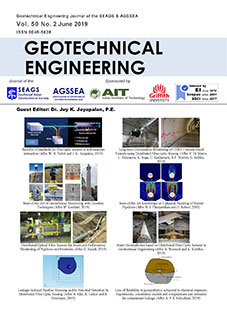Loss of Flexibility in Geosynthetics Subjected to Chemical Exposure: Experiments, Constitutive Models and Computations and Estimates for Contaminant Leakage
Main Article Content
Abstract
The paper presents results of recent research related to the development of advanced mathematical models for describing the behaviour of strain rate sensitive materials such as geosynthetics that are used extensively as barriers to the migration of contaminants and other hazardous materials. The important finding of the research is that the leaching of the plasticizer from the geosynthetic can lead to a loss of hyperelasticity of the material, which is a key functional requirement for a geosynthetic. It is also shown that constitutive models can be developed to describe the mechanical behaviour of the geosynthetic in its virgin state and upon direct exposure to pure ethanol for thirteen months. A computational approach is used to evaluate the results of separate laboratory experiments involving transverse indentation of geosynthetic membranes that are fixed along a circular boundary and tested in either its untreated state or after prolonged exposure to ethanol.
Article Details

This work is licensed under a Creative Commons Attribution-NonCommercial-NoDerivatives 4.0 International License.
Copyright © 2019 Association of Geotechnical Societies in Southeast Asia (AGSSEA) - Southeast Asian Geotechnical Society (SEAGS).


